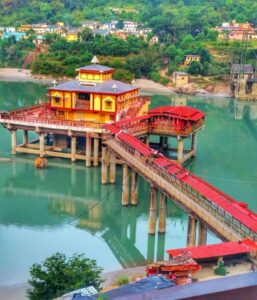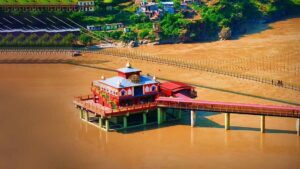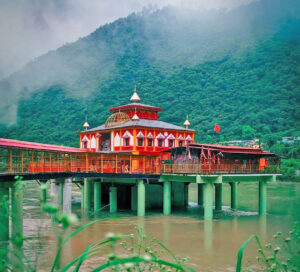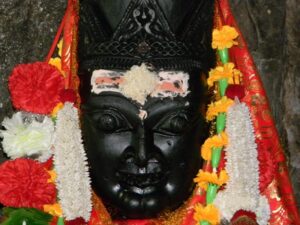Rishikesh to Dhari Devi


The distance between Rishikesh and Dhari Devi Temple is approximately 30 to 35 kilometers, depending on the specific route taken. The journey usually takes around 1 to 1.5 hours by road, considering the hilly terrain and winding roads in the region.
Dhari Devi, a revered shrine in Uttarakhand, India, is dedicated to Goddess Dhari, a manifestation of the divine feminine. The temple holds a significant position along the banks of the Alaknanda River near Srinagar in the Garhwal region. What makes Rishikesh to Dhari Devi unique is the ancient idol, traditionally depicted as the upper half of a goddess emerging from the rock, symbolizing the upper part of the body of Maa Kali. The temple is often associated with the protection

of the region, and local folklore tells the story of the goddess protecting the area during floods.
The spiritual significance and natural beauty of the surroundings make Dhari Devi a sacred pilgrimage site. However, the temple also faced controversy during the construction of a hydroelectric project, leading to the relocation of the idol in 2013. Despite the changes, Rishikesh to Dhari Devi remains a symbol of both spiritual devotion and the delicate balance between progress and preserving the sanctity of ancient religious sites in the Himalayan region.
The Dhari Devi temple, once situated at Kalyasaur along the banks of the Alaknanda River, held a unique position in the hearts of locals and pilgrims alike. The temple was known not only for its religious significance but also for the legendary belief that the goddess, in the form of the idol, protected the region from natural calamities, especially during floods.
In 2013, controversy surrounded the temple when authorities decided to relocate the idol as part of a hydroelectric project. This decision led to a tragic event, as it was believed that the goddess expressed her displeasure at being moved.

According to local lore, her idol, when placed in a temporary location, caused havoc in the region, leading to landslides and destruction. Subsequently, the idol was installed at a new location near Srinagar, marking a significant change in the temple’s history.
The incident surrounding the relocation of Rishikesh to Dhari Devi highlights the complex interplay between development projects and the preservation of sacred sites in the Himalayan region.
The temple, now in its new location, continues to attract devotees seeking the blessings of Goddess Dhari. The episode underscores the deep-rooted spiritual connection that communities share with their sacred spaces, emphasizing the delicate balance required when implementing developmental initiatives in culturally rich and environmentally sensitive regions.
The story of Rishikesh to Dhari Devi extends beyond the physical relocation of the idol; it delves into the profound spiritual and cultural fabric of the region. Many locals passionately believe in the deity’s protective powers, and the events surrounding the temple’s relocation sparked debates about the sanctity of sacred spaces amidst the changing landscape of Uttarakhand.

The Rishikesh to Dhari Devi incident prompted discussions about the environmental impact of large-scale projects in the fragile Himalayan ecosystem. It raised questions about the balance between economic development and preserving the spiritual and ecological heritage of the region. The controversy around the temple underscored the need for a nuanced approach to development that considers both the tangible and intangible aspects of a community’s identity.
The goddess, in her new abode near Srinagar, continues to draw devotees who seek solace, protection, and divine intervention. The narrative of Dhari Devi serves as a reflection of the intricate interplay between the physical and metaphysical, tradition and progress, highlighting the challenges faced by communities navigating the modernization of sacred landscapes while preserving their deep-rooted cultural and spiritual values.
Dhari Devi Temple is a Hindu temple located in the state of Uttarakhand, India. It is situated on the banks of the Alaknanda River, which is one of the major tributaries of the Ganga River. The temple is dedicated to Goddess Dhari, who is considered a manifestation of the goddess Kali.
Information about Dhari Devi Temple:
Location
Dhari Devi Temple is situated near the town of Srinagar in the Pauri Garhwal district of Uttarakhand. The temple is specifically located at Kalyasaur along the Srinagar-Badrinath Highway.
Religious Significance
The temple holds immense religious significance, and local legends and beliefs are associated with Goddess Dhari. According to one popular legend, it is believed that the goddess protects the region and its inhabitants from natural calamities.
Idol of Dhari Devi
The main idol in the temple is a large black stone idol of Goddess Dhari. The idol is revered for its protective powers, especially against floods and other natural disasters.
Shrine’s Relocation
There has been controversy and historical significance related to the relocation of the Dhari Devi idol. In 2013, during the devastating floods in Uttarakhand, the temple and the idol were relocated from its original place in the riverbed to a higher location to protect it from potential damage caused by the rising waters.
Festivals
Various Hindu festivals are celebrated at Dhari Devi Temple, attracting pilgrims and devotees from the surrounding regions. Navratri is a significant festival dedicated to Goddess Dhari.
Access
The temple is accessible by road, and pilgrims often visit it as part of their journey to the Char Dham Yatra, a pilgrimage to four sacred shrines in Uttarakhand, including Yamunotri, Gangotri, Kedarnath, and Badrinath.
1. What is the story behind Dhari Devi temple?
The Dhari Devi temple, located in the Uttarakhand state of India, is associated with a mythological legend involving the goddess Kali. According to the legend, the temple is dedicated to Dhari Devi, who is believed to be a manifestation of the goddess Kali.
The story goes that the idol of Dhari Devi was originally situated in the village of Kalimath. When a devastating flood struck the region, the villagers witnessed the idol of Dhari Devi floating in the floodwaters. The villagers attempted to rescue the idol, but the goddess appeared to them in the form of a young girl and asked them to let her go, promising to reappear downstream at a place called Kalyasaur.
True to her word, the idol of Dhari Devi was found at Kalyasaur, where a new temple was built in her honor. The Dhari Devi temple at Kalyasaur became a revered pilgrimage site, and the goddess is believed to protect the region from natural calamities, particularly floods.
However, controversy arose in 2013 when the government of Uttarakhand decided to relocate the idol of Dhari Devi to make way for a hydroelectric project. It is believed that soon after the idol was moved, devastating floods struck the region, leading to widespread destruction and loss of life.
Many locals and devotees interpreted this as the wrath of Dhari Devi, angered by the relocation of her idol. As a result, there were calls to return the idol to its original location at Kalyasaur. Eventually, the government yielded to public pressure, and the idol was returned to the Dhari Devi temple at Kalyasaur.
The legend of Dhari Devi is deeply ingrained in the culture and beliefs of the people of Uttarakhand, and the temple continues to be an important pilgrimage site for devotees seeking the blessings and protection of the goddess.
2. Is Dhari Devi a Shakti Peeth?
No, Dhari Devi temple is not considered one of the 51 Shakti Peethas. The Shakti Peethas are a group of sacred sites in Hinduism dedicated to various forms of the goddess Shakti, also known as Devi or the Divine Mother. These sites are believed to be where body parts of the goddess Sati fell when her corpse was dismembered by Lord Vishnu’s Sudarshana Chakra, following her self-immolation in grief over the death of her husband, Lord Shiva.
While Dhari Devi is revered as a manifestation of the goddess Kali and is worshipped by devotees seeking her blessings and protection, it is not classified as one of the Shakti Peethas. The Shakti Peethas have their own distinct locations and significance within Hindu mythology and pilgrimage traditions.
3. What is the mystery of Maa Dhari Devi?
The “mystery” surrounding Maa Dhari Devi primarily revolves around the events related to the relocation of her idol and the subsequent catastrophic floods in the Uttarakhand region.
The controversy began in 2013 when the Uttarakhand government decided to relocate the idol of Maa Dhari Devi from its original temple location in the village of Kalyasaur to make way for a hydroelectric project. Many locals and devotees protested against the decision, fearing the wrath of the goddess.
Shortly after the idol was moved, devastating floods struck the region, causing widespread destruction and loss of life. This led to speculation and belief among many locals and devotees that the floods were a result of the anger of Maa Dhari Devi at the relocation of her idol.
The events surrounding the relocation of Maa Dhari Devi’s idol and the subsequent floods gave rise to various interpretations and theories, with some attributing the disaster to divine retribution and others viewing it as a consequence of human actions.
The controversy and subsequent events have contributed to the “mystery” surrounding Maa Dhari Devi, leading to ongoing discussions, debates, and reflections on the significance of faith, nature, and human intervention in the region.

